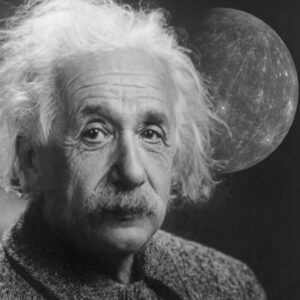Science Seen Physicist and Time One author Colin Gillespie helps you understand your world.
Space Mass
‘It is indeed an exacting requirement to have to ascribe physical reality to space in general, and especially to empty space.’ — Albert Einstein
Most physicists work in a vacuum. That is, they tend to think in terms of particles in empty space. But both Albert Einstein and recent evidence say they are wrong: Far from empty, space is massive. What is this telling us?
Let’s take a look. First the evidence: We can “see” the intense visible light that was let loose when neutral atoms formed from cooling ionized plasma some 370,000 years after the Big Bang. Let’s call this light the Big Flash. In the ensuing 13.8 billion years, Big Flash light stretched out to longer (invisible microwave) wavelengths as space expanded, so we need instruments to see it. Since 1992, microwave detectors on satellites have mapped this Cosmic Microwave Background to give us an increasingly precise image “taken” with the Big Flash. The universe’s baby picture is now so well-known you can search for it with “CMB”.
This Big Flash picture tells us much about the contents of our universe. The latest data from the Planck satellite say that so-called  “empty space” has a mass that is about fourteen (plus or minus one) times more than the mass of all the matter we can see—the galaxies, their stars and planets, moons and asteroids, clouds of gas, you name it. This information contradicts the way that we all think of space. It challenges us to ask: What is space? If we could find an answer it would give us a better understanding of our world.
“empty space” has a mass that is about fourteen (plus or minus one) times more than the mass of all the matter we can see—the galaxies, their stars and planets, moons and asteroids, clouds of gas, you name it. This information contradicts the way that we all think of space. It challenges us to ask: What is space? If we could find an answer it would give us a better understanding of our world.
As every detective knows, two clues are better than one. Here is another: We can see that space is still expanding. Every day, there is more space. Indeed, the 2011 Nobel Prize in physics was awarded for discovering that, far from slowing, its expansion is accelerating. Whatever’s making that new space is working harder. We call it Dark Energy. Nice label but this doesn’t tell us what it is. What could it be? This is the biggest unsolved puzzle in physics.
Now let’s add this: Most of the matter in the universe (85 percent of it) somehow manages to be invisible. This too could be a clue. We call it Dark Matter. But what is it? This is the second biggest unsolved puzzle in physics.
Various fields of physics are working—unsuccessfully so far—to unscramble each of these fundamental puzzles. Note that, between them, they cover almost the entire contents of the universe. It seems like all we understand is that we understand almost nothing.
But wait! A small tweak in our world-view changes everything. Suddenly all of these puzzles have simple answers. What’s the tweak? Well it’s the same tweak that began with Bernhard Riemann in 1856, the tweak that now offers us a whole new way to understand the point that was the universe before the Big Bang. That’s now four deep explanations for the price of one.
All we need to do is view string theory’s pet object (the Calabi-Yau manifold) as real and assume that it can be unstable so, where is high curved (Einstein again) it replicates.
So here is a message from the Planck-scale world that gives us a new way to think about reality. Space is not nothing; it is something. It has form, though too small for us to see. It has mass, though too small for us to feel. Matter and energy are made of it.
And what’s making that new space? It’s simple; space is.
Sources:
Albert Einstein (1952), “Relativity and the Problem of Space”, in Relativity: The Special and the General Theory, 5th edition, (1954), http://www.relativitybook.com/resources/Einstein_space.html
Other Materials:
Dwight Murphey & David Miller (2013), “An Intellectual Mind-Twister for Our Readers: Going to the Outer Limits of Cosmology”, J. Soc. Pol. Ec. Stud., vol. 38, p. 235; http://dwightmurphey-collectedwritings.info/JSPES-TimeOne-BkRevArticle%284%29a.htm

No comments yet.